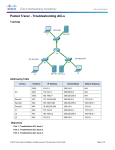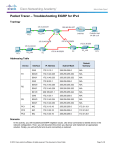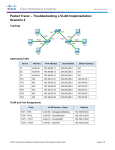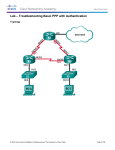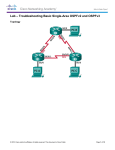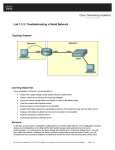Download Packet Tracer – Verifying and Troubleshooting NAT Configurations
Transcript
Packet Tracer – Verifying and Troubleshooting NAT Configurations Topology Addressing Table Device Interface IP Address Subnet Mask Default Gateway G0/0 10.4.10.254 255.255.255.0 N/A G0/1 10.4.11.254 255.255.255.0 N/A S0/0/1 10.4.1.2 255.255.255.252 N/A S0/0/0 209.165.76.194 255.255.255.224 N/A S0/0/1 10.4.1.1 255.255.255.252 N/A Server1 NIC 64.100.201.5 255.255.255.0 64.100.201.1 PC1 NIC 10.4.10.1 255.255.255.0 10.4.10.254 PC2 NIC 10.4.10.2 255.255.255.0 10.4.10.254 L1 NIC 10.4.11.1 255.255.255.0 10.4.11.254 L2 NIC 10.4.11.2 255.255.255.0 10.4.11.254 R1 R2 Objectives Part 1: Isolate Problems Part 2: Troubleshoot NAT Configuration Part 3: Verify Connectivity © 2013 Cisco and/or its affiliates. All rights reserved. This document is Cisco Public. Page 1 of 2 Packet Tracer – Verifying and Troubleshooting NAT Configurations Scenario A contractor restored an old configuration to a new router running NAT. But, the network has changed and a new subnet was added after the old configuration was backed up. It is your job to get the network working again. Part 1: Isolate Problems Ping Server1 from PC1, PC2, L1, L2, and R2. Record the success of each ping. Ping any other machines as needed. Part 2: Troubleshoot NAT Configuration Step 1: View the NAT translations on R2. If NAT is working, there should be table entries. Step 2: Show the running configuration of R2. The NAT inside port should align with the private address, while the NAT outside port should align with the public address. Step 3: Correct the Interfaces. Assign the ip nat inside and ip nat outside commands to the correct ports. Step 4: Ping Server1 from PC1, PC2, L1, L2, and R2. Record the success of each ping. Ping any other machines as needed. Step 5: View the NAT translations on R2. If NAT is working, there should be table entries. Step 6: Show Access-list 101 on R2. The wildcard mask should encompass both the 10.4.10.0 network and the 10.4.11.0 network. Step 7: Correct the Access-list. Delete access-list 101 and replace it with a similar list that is also one statement in length. The only difference should be the wildcard. Part 3: Verify Connectivity Step 1: Verify connectivity to Server1. Record the success of each ping. All hosts should be able to ping Server1, R1, and R2. Troubleshoot if the pings are not successful. Step 2: View the NAT translations on R2. NAT should display many table entries. © 2013 Cisco and/or its affiliates. All rights reserved. This document is Cisco Public. Page 2 of 2


